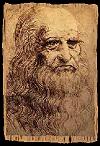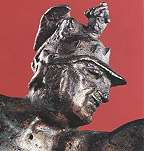|
Though we know Leonardo considered sculpture dirty work, "of lesser genius than painting", and a "wholly mechanical exercise",there are a number of pieces which he may have carried out. Part of Leonardo's apprenticeship under Verrocchio was the study of sculpture and Vasari recorded him as having made some "heads of women laughing". Leonardo himself tells us that he has worked, "no less in sculpture than in painting, being equally adept at one and the other." Many scholars now go as far as to attribute some of Verrocchio's better-known works of sculpture to a young Leonardo. The most noteworthy of these is the Bust of a Woman with Flowers, which is now increasing attributed to Leonardo. This work is significant for being the first bust in Renaissance art which displayed the hands. It is probably of Ginevra de' Benci and was done between 1475-1480. Another sculpture, which was previously attributed to Verrocchio, is the wax bust of a semi-naked woman which is in the collection of the Kaiser Fredrich Museum, Berlin.
At this
stage in time there is only one sculpture of Leonardo's over
which no doubt is thought Like his initial designs for both the Statue of Francesco Sforza and for the Trivulzio Monument this piece has the horse rearing on its hind legs. Obviously Leonardo managed to form in miniature what he was unable to complete with the two aforementioned monuments, neither of which was carried to fruition. After Leonardo's death King Francis I expressed a desire to have this piece made into a full size monument. His wish was never carried out, nor indeed ever started, however there is some evidence the king admired this piece all of his life. It is now in the collection of the Museum of Budapest. Another piece which is almost certainly by Leonardo is The Young Christ. Done between 1470-1480, it is done in terracotta which was a particularly popular medium at the time. Most of the other pieces in question are small bronzes of horses, with and without riders, rearing and walking. There is also one of a fallen warrior, a bust of an unknown woman done in terracotta, and one of a girl done in wax. Leonardo supervised Giovan Francesco Rustici in his work on the bronze grouping of St. John the Baptist Teaching. This work stands in front of the Baptistery in Florence, and has been in place since 1511. Leonardo's influence can be clearly seen in the upraised finger which was to be seen so often in his paintings. In 1504-15-05 Leonardo drew The David of Michelangelo with Variations. He was then invited by the Florentine Republic to sit on the committee formed to determine a suitable site in which to place the statue. (Information on Leonardo's equestrian monuments is documented under the Drawings section of this Web site). |
|


 to
exist and it is only recently that research led to new conclusions
about this small bronze of a Horse and Rider. Records
dating back to 1584 show Leonardo probably made a number of
models of horses for his final patron, King Francis I and it
is now considered this iis probably one of those works. This
would date it to somewhere between 1516-1519.
to
exist and it is only recently that research led to new conclusions
about this small bronze of a Horse and Rider. Records
dating back to 1584 show Leonardo probably made a number of
models of horses for his final patron, King Francis I and it
is now considered this iis probably one of those works. This
would date it to somewhere between 1516-1519.